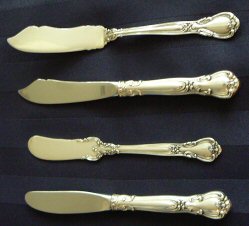 W
WIn common usage, a butter knife may refer to any non-serrated table knife designed with a dull edge and rounded point; formal cutlery patterns make a distinction between such a place knife and a butter knife. In this usage, a butter knife is a sharp-pointed, dull-edged knife, often with a sabre shape, used only to serve out pats of butter from a central butter dish to individual diners' plates. Master butter knives are not used to spread the butter onto bread: this would contaminate the butter remaining in the butter dish when the next pat of butter was served. Rather, diners at the breakfast, the luncheon, and the informal dinner table use an individual butter knife to apply butter to their bread. Individual butter knives have a round point, so as not to tear the bread, and are sometimes termed butter spreaders. If no butter spreaders are provided, a dinner knife may be used as an alternative.
 W
WA cake and pie server, also called a cake shovel, pie knife, crépe spade, pie-getter, pie lifter, pie spatula, cake knife, or cake slice is a serving utensil used in the cutting and serving of pies and cakes. Some cake and pie servers have serrated edges. Another use can be to serve pizza.
 W
WCaviar spoons are traditionally made of inert materials, such as animal horn, gold, mother of pearl, and wood. They range in length from 7 to 13 cm, and have a small shallow bowl that may be either oval or paddle shaped.
 W
WChopsticks are shaped pairs of equal-length sticks that have been used as kitchen and eating utensils in most of East Asia for over three millennia. They are held in the dominant hand, secured by fingers, and wielded as extensions of the hand, to pick up food.
 W
WA ladle is a type of cooking implement used for soup, stew, or other foods.
 W
WA salt spoon is a miniature utensil used with an open salt cellar for individual service. It is a historical and nostalgic item from a time before table salt was free-flowing, as it is today. The spoon itself ranges from 2 to 3 inches long and has a circular bowl measuring approximately 0.5 to 0.75 inches. They can be found in a wide range of materials including glass, Sterling silver, plastic, wood, ivory, bone and shell.
 W
WIn common usage, a scoop is any specialized spoon used to serve food.
 W
WA slotted spoon is a spoon implement used in food preparation. The term can be used to describe any spoon with slots, holes or other openings in the bowl of the spoon which let liquid pass through while preserving the larger solids on top. It is similar in function to a sieve; however, a ladle-sized slotted spoon is most typically used to retrieve items from a cooking liquid while preserving the liquid in the pot, while table-sized slotted spoons are often used to serve foods prepared or packaged in juices, such as canned fruit and vegetables.
 W
WA soup spoon is a type of spoon with a large or rounded bowl, used for consuming soup. The term can either refer to the British soup spoon or the Chinese spoon. Round bowled soup spoons were a Victorian invention. Sets of silverware made prior to about 1900 do not have round soup spoons; a tablespoon was used.
 W
WSpoon and chopstick rest is a piece of tableware for resting a spoon and chopsticks without touching the table. In Korean cuisine context, it can be referred to as sujeo rest as sujeo is a paired set of spoon and chopsticks, which is very common in Korea.
 W
WA sugar spoon is a piece of cutlery used for serving granulated sugar. This type of spoon resembles a teaspoon, except that the bowl is deeper and often molded in the shape of a sea shell, giving it the name sugar shell. Sugar spoons are sometimes called "sugar shovels" because of their rectangular shape and deep bowl. Sterling silver sugar spoons are used with formal silver coffee or tea sets.
 W
WA toffee hammer is a very small hammer designed for breaking up sheets or slabs of hard toffee, such as bonfire toffee, into small pieces suitable for consumption. A toffee hammer is sometimes included as a novelty item in gift packs produced by toffee manufacturers.
 W
WTongs are a type of tool used to grip and lift objects instead of holding them directly with hands. There are many forms of tongs adapted to their specific use.Tongs that have long arms terminating in small flat circular ends of tongs and are pivoted at a joint close to the handle used to handle delicate objects. Common fire-tongs, used for picking up pieces of coal and placing them on a fire without burning fingers or getting them dirty are of this type. Tongs for grilling, tongs for serving salad or spaghetti are kitchen utensils of the same type. They provide a way to move, rotate and turn the food with delicate precision, or fetch a full serving in one grab. Tongs consisting of a single band of bent metal, as in sugar tongs, most asparagus tongs and the like. Sugar tongs are usually silver, with claw-shaped or spoon-shaped ends for serving lump sugar. Asparagus tongs are usually similar but larger, with a band near the head that limits how far the tongs can expand. Asparagus tongs for serving were introduced in 18th-century England, with smaller versions for eating asparagus appearing in the 19th century. Tongs in which the pivot or joint is placed close to the gripping ends are used to handle hard and heavy objects. Driller's round tongs, blacksmith's tongs or crucible tongs are of this type.